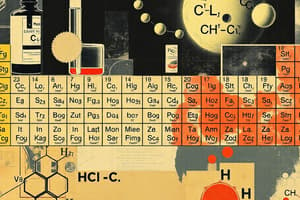Podcast
Questions and Answers
Which statement about metals is accurate?
Which statement about metals is accurate?
- Metals can be shaped into thin sheets and drawn into thin wires. (correct)
- Metals do not conduct electricity at room temperature.
- Metals are brittle and cannot be shaped or drawn.
- Metals have low melting and boiling points due to weak interatomic forces.
What is the main reason for the high melting and boiling points of metals?
What is the main reason for the high melting and boiling points of metals?
- Strong interatomic forces (correct)
- Low density
- High electrical resistance
- Weak interatomic forces
What happens when metals are struck?
What happens when metals are struck?
- They produce a ringing sound due to vibration. (correct)
- They produce a crackling noise similar to breaking glass.
- They emit a low buzzing sound.
- They remain silent and do not produce any sound.
Which property is NOT associated with metals?
Which property is NOT associated with metals?
"Solid metals at room temperature conductors" act as exceptions because:
"Solid metals at room temperature conductors" act as exceptions because:
What property allows metals to be shaped into thin sheets and drawn into thin wires?
What property allows metals to be shaped into thin sheets and drawn into thin wires?
What is the main reason for the high melting and boiling points of metals?
What is the main reason for the high melting and boiling points of metals?
What is the significance of the ringing sound produced by metals when struck?
What is the significance of the ringing sound produced by metals when struck?
Why are solid metals at room temperature conductors considered exceptions?
Why are solid metals at room temperature conductors considered exceptions?
What property of malleable metals allows them to be hammered or rolled into solid shapes?
What property of malleable metals allows them to be hammered or rolled into solid shapes?
Flashcards are hidden until you start studying
Study Notes
-
We are currently exploring the next chapter in "Concept Mapping and Reviewing" on our amzing platform, dedicated to metals and non-metals.
-
We will delve deeper into each topic of metals and non-metals, ensuring clear comprehension with much delight for children.
-
If reading about metals and non-metals is required, it would be beneficial to understand their properties first.
-
Metals are malleable and can be shaped into thin sheets. They can also be drawn into thin wires.
-
Malleable metals are strong and can be hammered or rolled into solid shapes.
-
Metals have high melting and boiling points due to their strong interatomic forces.
-
Solid metals and room temperature conductors are exceptions for metals in the context of marking. They can be placed in the liquid state in room temperature conductors and act as an electrolyte.
-
When metals and sunoras metals are struck, they produce a ringing sound that resembles the sound of a bell in old schools.
-
This ringing sound is produced because metals and sunoras metals vibrate when struck.
-
We are currently exploring the next chapter in "Concept Mapping and Reviewing" on our amzing platform, dedicated to metals and non-metals.
-
We will delve deeper into each topic of metals and non-metals, ensuring clear comprehension with much delight for children.
-
If reading about metals and non-metals is required, it would be beneficial to understand their properties first.
-
Metals are malleable and can be shaped into thin sheets. They can also be drawn into thin wires.
-
Malleable metals are strong and can be hammered or rolled into solid shapes.
-
Metals have high melting and boiling points due to their strong interatomic forces.
-
Solid metals and room temperature conductors are exceptions for metals in the context of marking. They can be placed in the liquid state in room temperature conductors and act as an electrolyte.
-
When metals and sunoras metals are struck, they produce a ringing sound that resembles the sound of a bell in old schools.
-
This ringing sound is produced because metals and sunoras metals vibrate when struck.
Studying That Suits You
Use AI to generate personalized quizzes and flashcards to suit your learning preferences.




